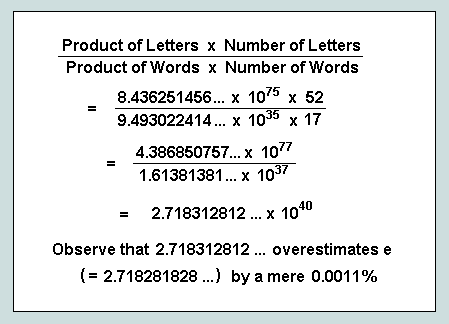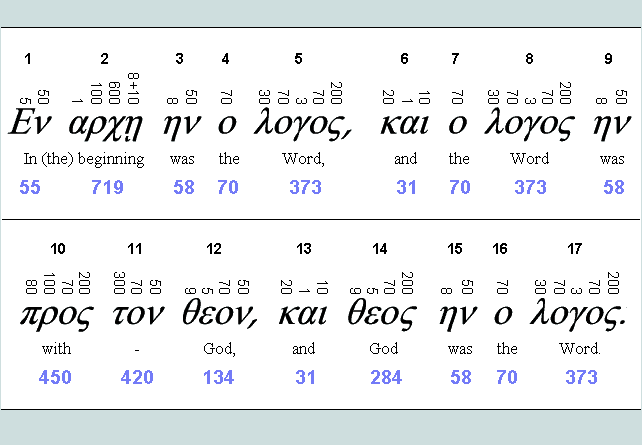
The evaluation of 'e' from within John 1:1
A simple procedure involving the letters and words of the first verse of the Hebrew Bible generates a large number - the first 5 digits of which accurately match the first 5 of the fundamental constant p. The same procedure applied to the Greek letters and words of the related verse, John 1:1, generates an even larger number of which the first 5 digits accurately match the first 5 of the fundamental constant e.
Here is the essential calculation as it relates to the second of these:

The details follow.
The first verse of the Gospel of John, as rendered in the original Greek, reads (left to right) as follows:

There are 17 words comprising a total of 52 letters. Since c600 BC each letter has also functioned as a numeral. The values so assigned are written above each letter. Each string of letters (the words, in this case) represents a number obtained by summing the letter values. These 17 results are recorded in blue beneath the translation. Their sum - the verse characteristic value - is 3627.
Before proceeding, something more needs to be said about the structure of the second word. Here, the last letter is seen to be subscripted by another, viz iota, this being the second element of a long vowel dipthong. In fact, therefore, the word has 5 letters; hence the entry "8 + 10" above the dipthong - 8 and 10 being the respective values of letters 4 and 5.
Detail of the Letter-Products
We now proceed, word by word, to determine the product of the letter values:

The final result is obtained by multiplying together these 17 numbers which encapsulate the letter products, thus:
(25 x 48x 4 x 7 x 882 x 2 x 7 x 882 x 4 x 112 x 105 x 1575 x 2 x 63 x 4 x 7 x 882) x 10^50
= (8.436251456) x 10^50
= 8.436251456 x 10^75
Detail of the Word-Products
This matter is more straightforward:

Vernon Jenkins MSc
2009-02-28
Acknowledgements:
The author is grateful to Bevan Williams who first drew attention to the phenomenon.